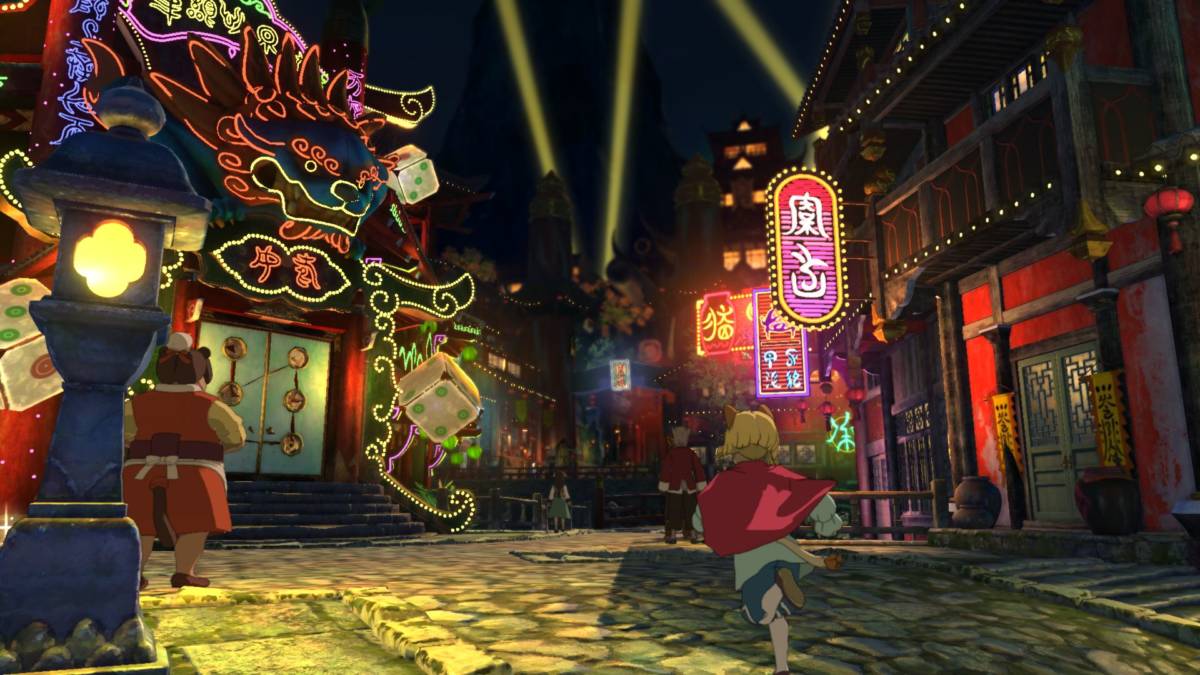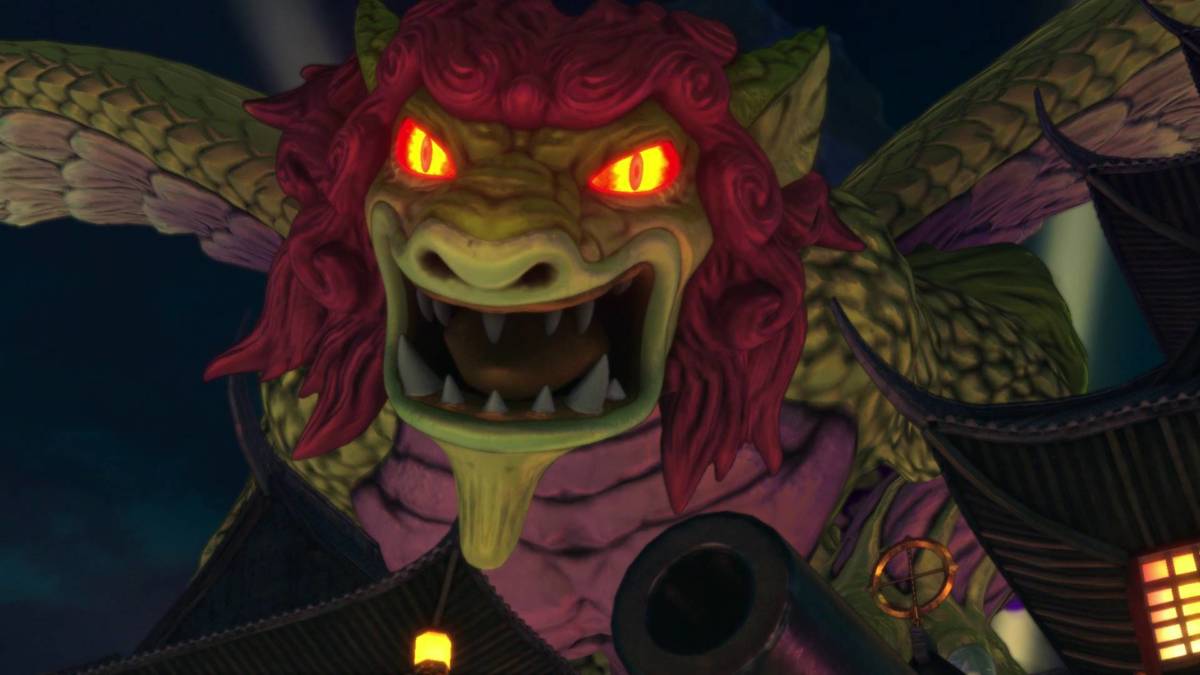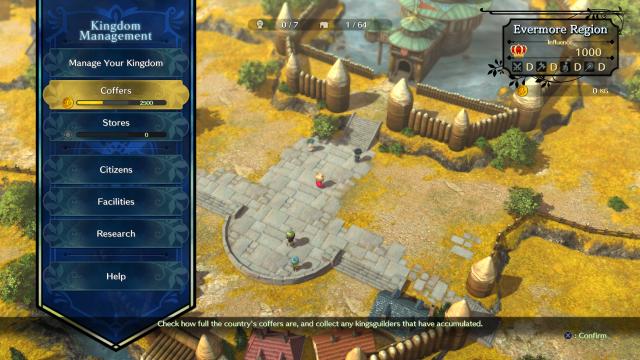Disclaimer: Bandai Namco Entertainment invited us to an exclusive press event at Hever Castle to play Ni no Kuni II: Revenant Kingdom, which included food, an overnight stay and, most importantly, a free bar.
It takes a lot of courage when making a sequel to fundamentally change key aspects of the original game. It’s all too easy to fall back into similar patterns in order to achieve repeat success, so we should commend those that dare to be different second time around. Ni no Kuni II: Revenant Kingdom is one such game.
The combat and gameplay in the original game focused on capturing creatures known as Familiars and utilising their skills in battle. Once in a fight, events would play out in a pseudo-real-time fashion. You could move around in real time, but attacks and spells required pausing the game and selecting your next move. If you’ve played Final Fantasy XII, it’s along those lines. Ni no Kuni II says “sod all that” though, changing things up in a number of key ways.
Set hundreds of years after the events of the first game, you control Evan, the former King of a town named Ding Dong Dell who was deposed and exiled by a rival faction. But Evan is a strong lad with plenty of grit. Instead of giving up, he aims to realise a lofty ambition: forming his own kingdom that welcomes people of all cultures. Aiding him on his quest are Roland, Evan’s advisor and protector, Batu, the leader of a band of sky pirates, and Tani, Batu’s daughter.

The early portion of the game sees you travelling around, running errands for people who can help you kickstart your kingdom. The demo we played picks up at the tailend of that, as we travelled to the gambling city of Goldpaw to beg for investment from the ruler Pugnacious. The saying “nothing is left to chance” means nothing at Goldpaw, as entire laws and legal proceedings are decided on the roll of a dice. But of course, things aren’t as they seem, as you begin uncover a conspiracy aimed at conning the civilians out of money. A gambling city that’s corrupt? Shut the front door.
Whilst this portion of the demo was heavy on the story elements, we were finally let loose on some enemies after a few cutscenes. Combat is a fairly basic affair, with square and triangle controlling light and heavy attacks, R1 is for ranged attacks which you can charge for extra damage, and L1 is your block and evade button.
There are no familiars, but you can control different members of your party who each have different moves and a unique playstyle. Evan is quick, but deals minimal damage, whilst Batu hits like a truck but takes ages to swing. Roland sits in the middle, making him the god damn MVP of this game, whilst Tani is similar to Evan but has unique moves like stealing items.
Holding R2 brings up your skills wheel, which include spells, buffs and devastating attacks, and each attacks costs a certain amount of magic. Each character has up to five blocks of magic that can be refilled by whacking enemies, which is good as it incentivises a more aggressive playstyle. No waiting at the back of the fight for your mana to recharge.

The normal fights that you encounter in the overworld felt a little trivial, but that might have had more to do with the build we were given, as the entire party was a few levels above the enemies we were facing. Thankfully, the boss fights more than made up for the gulf in difficulty, as you would expect. That being said, Ni no Kuni II has been described as family friendly, and a great game to play with your wee ones, so perhaps it’s better off this way.
Though the combat sounds fairly basic, the Tactics Tweaker adds a layer of depth beyond just equipping armour and smacking things until they fall over. Using multiple sliders, you can alter stats like your resistances to certain element over others, to doing more damage to solid enemies than others. You can even alter your drops to focus on money, exp or loot. It’s an added layer of strategy that could make the difference when entering dungeons. If you know you’re facing brute enemies, or lightning types, you can alter your loadout as such and have a much easier time.
All of this was presented with some absolutely gorgeous graphics, which look and feel like the best Studio Ghibli films made into 3D. The character design in particular strikes a great balance between typical anime style and some semblance of realism, creating characters that are actually believable.
Of course, that Studio Ghibli resemblance isn’t unintentional, as Level-5 collaborated with Studio Ghibli on the first game, and they’ve brought back Joe Hisaishi to compose more music for this game. You may know him from fan favourite Ghibli films such as Spirited Away and My Neighbor Totoro. He’s done a wonderful job here creating a score that’s both catchy and emotive. More than a few times, I found myself whistling along to the tune as I wandered around Goldpaw.

After solving all the problems for Goldpaw in part 1 of the demo, part 2 introduced more new mechanics and gameplay elements into the mix. With all the pieces in place, Evan sets about constructing his new kingdom, the kingdom of Evermore. And if early indications are anything to go by, you’ll be building this kingdom for-Evermore. No, shut up. The joke works.
You’re in charge of constructing various facilities in your kingdom, such as shops, farms and mining camps, all of which will provide Kingsguilders which you can use to build more facilities or upgrade current buildings. Got to spend money to make money, right? Once you’ve built the facilities, you can use them to create new weapons, armour, spells and more, which means that maintaining your kingdom will become one of the most important aspects of the game.
Though we were only given a taste of what this portion of the game has to offer, the potential is already there for it to become dangerously addictive. Even just the idea of being able to watch your kingdom being built from nothing to becoming self sufficient and thriving is a tantalising one.
This section of the game also introduced us to a new kind of dungeon: the Dreamer’s Maze. You’re plonked into the center of a randomly generated maze and must find the door to progress further into the dungeon, eventually fighting a boss at the end. Certain RPG fans may compare it to the likes of Persona 3 and 4, but it displays similarities to another Level-5 title, Dark Cloud. Completing these dungeons forms part of one of the many side quests in Ni no Kuni II: Revenant Kingdom, making it a great optional challenge for someone looking for enemies that fight back.

Less impressive is the Skirmish Mode, which swaps fights against two to three creatures for larger scale battles with different enemies. You control up to 4 units which circle around Evan at one time, and it’s your job to maneuver them around to tackle the approaching threats. In theory, it’s supposed to be a rock paper scissors mechanic, with certain types of units beating others, but the demo didn’t show that in the best light.
As the demo only gave us access to two units, fights were less of a case of strategy and more about mashing your units against their units until their units fell over. There were abilities like air strikes and stun attacks which can turn the tide of battle, giving you some control over the proceedings, but the mode wasn’t as immediately gratifying as building a kingdom or beating the crap out of a manticore with the traditional battle system.
Still, we’ve every faith that Level-5 will flesh out Skirmish Mode in the full game, making it a worthwhile and delightful part of a game already bursting with enjoyable elements. Anyone who hasn’t played the original game should be able to enjoy it regardless when it comes out in March, but fans of Ni no Kuni should know that the series is still in good hands.
If you’re looking for more gaming coverage from us, check out our reviews for Under Night: In-Birth EXE Late(st) and Bleed 2. Or don’t. It’s fine.
Some of the coverage you find on Cultured Vultures contains affiliate links, which provide us with small commissions based on purchases made from visiting our site.

